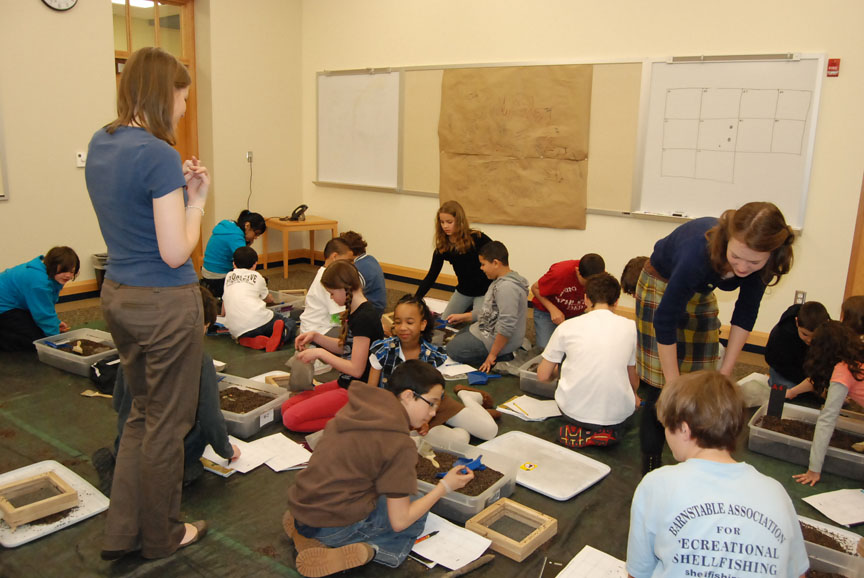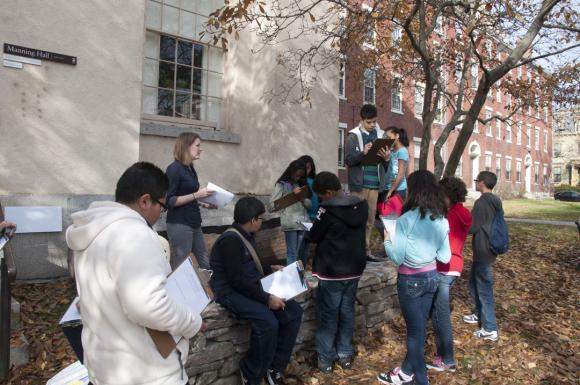It’s a long journey for any ancient artifact to make: from discovery among ancient ruins to a place in a museum exhibit. That’s the journey local sixth-graders are learning about in “Think Like an Archaeologist,” a program developed by Brown’s Joukowsky Institute for Archaeology and the Ancient World, the Haffenreffer Museum of Anthropology, and the RISD Museum of Art.
The two-year-old program, which currently works with social studies students at Nathan Bishop and Nathaniel Greene middle schools in Providence, is broken into four in-class sessions where students are introduced to the field of archaeology, studying artifacts and performing a mock dig where they piece together information on a specific culture. A fifth session brings the students on a field trip to the Haffenreffer Museum and the RISD Museum of Art to get an up-close look at artifacts. Since it began, more than 400 children in Providence schools have taken part in the program.

The brainchild of Sarah Sharpe, manager at the Joukowsky Institute; Geralyn Ducady, the Haffenreffer’s curator of programs and education; and Mariani Lefas-Tetenes, educator for school and teacher programs at the RISD Museum, the program began to take shape four years ago when Sharpe was looking for a way to bring the Joukowsky Institute’s work into local schools. Realizing that the RISD Museum and the Haffenreffer already had similar, albeit smaller, programs in place, she approached Lefas-Tetenes and Ducady to partner.
“In partnering, we knew it would be a more cohesive program that had different parts based on our strengths and more takeaway for the students involved,” Sharpe said.
The program was piloted in 2010 as eight after-school sessions. Although the pilot was well-received, the three realized that a few tweaks could make it more beneficial to the students, including condensing it to a four-session format and integrating it into the school day, when students are less tired and more attentive.
This semester there were two sessions: March 14, 15, 16 and 21 and another to come on April 23, 25, 30 and May 2.
Sharpe, Ducady, Lefas-Tetenes, and graduate students developed a minute-by-minute script for each session, which enables teachers to participate in the program. The three credit those teachers with much of the program’s success.
“The teachers we work with are real collaborators,” Sharpe said. “They reinforce the messages we teach and we are able to refine what we do, gaining knowledge of what works and what doesn’t, based on that collaboration.”
Christopher Audette, a sixth-grade social studies teacher at the Nathan Bishop Middle School, says Think Like an Archaeologist adds another dimension of learning to his curriculum. “The students are totally engaged in the programs. The various sessions have sparked a new-found interest in archaeology at our schools, and these programs really make the subject come alive for the students,” Audette said.
Graduate students working at all three institutions also get involved, helping to teach various sessions. That experience not only provides them with valuable teaching time, but the sixth-grade students also get exposure to people who have real-world experience applying the skills they’ve learned in the program to actual archaeological digs.
“I came to Brown to learn about the most effective ways to teach others about archaeology. Being a part of Think Like an Archaeologist, I’m not only putting classroom theory into action but learning a great deal myself. The partner institutions show me different disciplinary perspectives, and the sixth-graders’ questions often challenge me to think about archaeology in completely different ways,” said Jessica Unger, a graduate student in American studies who interns at the Haffenreffer.
One of the highlights of the program for both students and organizers is the final session field trip. Two busloads of children trek to College Hill, one to spend an hour at the RISD Museum of Art and one at the Haffenreffer before switching. It takes considerable coordination on the parts of teachers and both institutions to make it happen, but Lefas-Tetenes says it’s well worth it.
“There are different nuances to each museum, and the students are lucky to have teachers that get the importance of both,” she said. "As students generate ideas about different types of objects at the museums, they're building meaning collaboratively, exercising their curiosity and applying their classroom learning."
In some cases, it is a student’s first visit to a museum or college campus, and it gets them thinking about the future. Sharpe says students often become inquisitive during the field trip, asking questions both about getting into college and working at a museum.
This session’s field trip will place on May 10.
Sharpe, Ducady and Lefas-Tetenes intend to grow the program slowly, but would like it to have a much broader reach. They say that Providence Public Schools curriculum specialist Kimberly Luca has been vital in growing the program to this point and say and will continue to be crucial to meeting their future goals. “The excitement around archaeologists and artifacts is really memorable to the students ... We hope to bring the program to every sixth-grade social studies student in Providence, so that they can all share in the experience,” Sharpe said.

